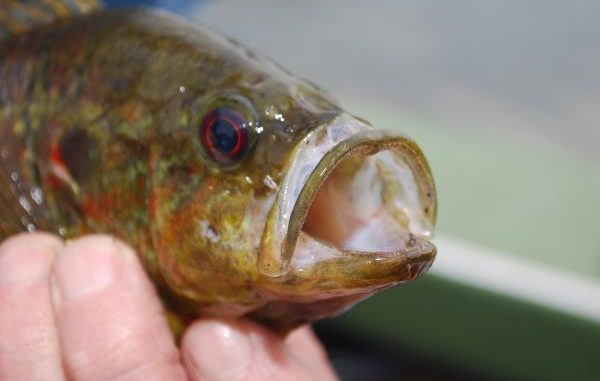
The goggle-eye is, with the possible exception of a spawning bull bluegill, the prettiest of the bream clan. Males are especially beautiful, with a body mottled with bright orange and olive and a bright red spot behind each gill cover and at the rear base of the dorsal fin.
And the eyes — on the brightest of specimens they’re blood red.
But the goggle-eye is better known for its huge mouth than its color. Its “accepted common name” (goggle-eye is considered a local name) of warmouth and its scientific name Lepomis gulosus both refer to its mouth. “Gulosus” means “large-mouthed” in Latin.
They put that big mouth to good use, eating virtually anything alive or anything that was once alive. Research shows that at smaller sizes — 1 to 3 inches long — they eat mainly insects, especially midge (a water-loving fly) and dragonfly larvae. Freshwater shrimp, small fish and very small crawfish are also eaten.
By 3 to 5 inches long, they increase their consumption of fish, crawfish and especially freshwater shrimp, although insects are still their No. 1 food item.
By 5 to 7 inches long, goggle-eyes switch their food preference strongly away from insects and freshwater shrimp to fish and crawfish. In crawfish-rich environments like the Atchafalaya Basin, they gorge on crawfish in the spring.
Many bass fishermen are well aware of the indiscriminating food habits of goggle-eye. They will jump on bottom-fished plastics, crankbaits, spinners and even topwater lures with abandon. Unfortunately, they just kind of give up after being hooked with heavy bass tackle, allowing the bass angler to crank them in without a fight.
Bream fishermen using ultralight rods and reels, and especially light jig poles get a lot more sport out of them. They don’t fight as ferociously as big bluegills, which turn sideways and run in tight circles, requiring the angler to “screw them out of the water,” but their sheer broad-shouldered bulk makes them a fun catch.
Goggle-eyes average larger than other bream, but don’t grow as large on the top end as do the bluegills or red ears (chinquapins or lake runners). The world-record bluegill is 4 pounds, 10 ounces, while the top redear is 5 pounds, 8 ounces. In comparison, the largest goggle-eye on record is 2 pounds, 11 ounces.
